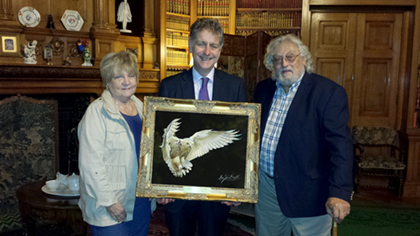Click here to goto Muncaster Pennington Castle Website
Thank again to the staff at Muncaster / Pennington Castle, and Cousin Mr Peter Frost-Pennington for working with me to set up the visit and opportunity to make the presentation of my painting “The Legend of The White Owl “to Peter and the Pennington family at the Castle on Thursday evening. What a Gracious host he was along with his wonderful assistant.
She took good photos with her camera which I am sure turned out much better than my phone camera.
The painting in the Library on display for the public to see as they take the fantastic tour of one of England’s most historical and fully working Castles. With the posting of this event on my web sit as well as the link to the Muncaster web page, I hope that others will come and enjoy the treasures that
the Pennington's and history of Muncaster Castle hold.
I plan to stay in contact with Peter and continue our relationship. My
Home is always open to the family if they ever get to St. Louis while in the
USA at any time. Peter ask me about a future painting of the Castle with all
the birds included. My mind is working overtime on some ideas. Prints are available by contacting me on my web site.
The Whit Owl is the only painting I have and will place my name as “Ron Hauser Pennington” Pennington was my given birth name.
History of the Castle
The Castle, believed to be standing on Roman remains, is a key part of the region's history. Whilst the Pennington family have recorded evidence of it being their home since 1208, some records go back further suggesting that the family have been here since at least 1026.
The Roman foundations would date back to 79AD and so the site itself is of historic significance. As with many great buildings, it has been built, extended and refurbished with almost every era in history. The last of these was by the fourth Lord Muncaster in 1885 by the famous architect, Salvin.
The lands were granted to Alan de Penitone in 1208 and fifty years later a castle was built by Gamel de Mulcastre. This was enlarged in the next century when a pele tower was erected on Roman foundations, part of its fabric being incorporated in the south-west tower. A coin from the time of Emperor Theodosius (AD380) has been found, and there is also a Victor ring.
In 1464 Sir John Pennington gave shelter to Henry VI, wandering after the Battle of Hexham. Many years later in 1783, John, Lord Muncaster erected the tower known as Chapels to commemorate the place where the fugitive King was supposed to have been found by the shepherds. The legend tells how Holy King Harry on his departure left his drinking bowl behind in gratitude, saying that as long as it should remain quite whole and unbroken the Penningtons would live and thrive in the place. Today the bowl is still intact and is known as the 'Luck of Muncaster'.
In the seventeenth and eighteenth centuries the family married well. In 1783 there was a vacancy in the Irish Peerage and the fifth Baronet was created first Baron Muncaster. He was a friend of Pitt and long a Member of Parliament. He carried out extensive renovations, planting most of the large hardwood trees. It was he who started the present library. He was succeeded by his brother, General Lowther Pennington, who in his youth was a hot head. While serving in America he killed a man in a duel called for a "foolish quarrel about humming a tune".
Shortly before his death in 1862, his grandson Gamel Augustus, fourth Lord Muncaster instructed Anthony Salvin, whose main interest was military architecture and who was very fashionable, to update the house. Salvin covered the courtyard, built by first Lord Muncaster, converting it into the present Drawing Room, with its much-admired barrel ceiling which was the work of two Italian plasterers. It was redecorated in 1958 by Lady Pennington-Ramsden.
In 1917, Gamel's brother, the fifth and last Lord Muncaster died and the estate reverted to his mother's family, the Ramsdens, who had played a notable part in the history of Yorkshire. With them they brought many of their possessions, including the Ramsden family portraits. In those days the estate still extended to 23,000 acres.
Sir John Pennington (my 16th great grandfather), gave sanctuary to King Henry
6th and saved his life during the “War of The Roses”.
